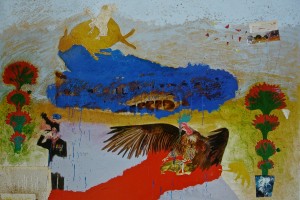It is a clamour: one the one hand, self-referentiality and personalization of the visualized narration, on the other, the abundance of visual references and even disclosures which go against self-reflection and turn the image into an anti-narrative. The picture of the Sudanese girl is at the centre of the horror of the image yet the vulture has changed position compared to Carter’s photograph, completing the photograph like a frame of a movie writing the whole story of the photographer’s suicide on canvas: this is the contradiction between disclosure and self-referentiality. The officer pointing a gun at his temple is the illustration of the moment before death and an interesting mediation between the two. On the top, there is something which can be considered the logo of American Eagle Outfitters attacking a collaged cow. The origin of this logo is related to the situation of an air-plane whose colour reminds one of both the sky and the sea and whose essence is sinking. However, after all there is the blue of the background reminding one of Gonzalez Torrs’ artworks and that he used to say, ‘if memory had a colour for me, it would have been light blue.’ What colour does our memory (what memory?) have? And by the way, what share of such memory does the flat lotus carvings of Persepolis have on two sides of the painting?

